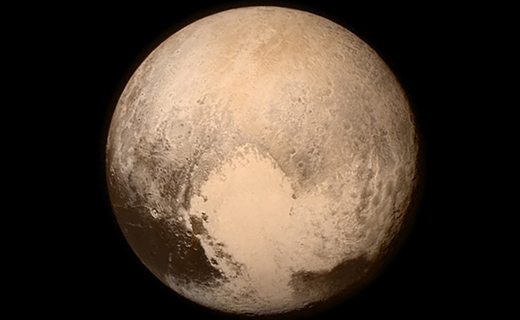
Applause erupted at NASA’s New Horizons control center in the wake of the eponymous spacecraft’s flyby of Pluto, considered to be the last unexplored planet in our solar system. The probe flew past it at 7:49 a.m. Eastern time on July 14, coming within 7,770 miles of Pluto’s surface and providing the first truly close-up photos of the planet ever taken.
This marked the completion of the craft’s nine-year journey, and resulted in the U.S. being the only country to now have explored every planet in the solar system. New Horizons quickly moved on past the planet, with its next check-in with Earth not scheduled until 8:53 p.m. E/T on July 15. At that point, it will have finished its data collecting during the mission, and will begin sending that information back to scientists.
That prospect is “like opening up a birthday present every day from now until the end of next year,” said Bonnie Buratti, a scientist at NASA’s Jet Propulsion Laboratory and a co-investigator on the mission. In the meantime, experts now have more than enough of those informational gifts to keep them busy.
They now have a precise measurement of Pluto’s diameter (it’s 1,472 miles); they know that enormous amounts of nitrogen are leaking from its atmosphere into space; they’ve confirmed that there are nitrogen and methane ices at its polar region; and spacecraft photography has revealed perfectly the planet’s color and terrain, which, according to mission co-investigator Paul Schenk, “looks like somebody painted it for a Star Trek episode.”
Principal investigator S. Alan Stern noted, “You can see regions of various kinds of brightness. Very dark regions near the Equator, very bright regions just to the north of that, broad intermediate zones over the pole. And on the surface we see a history of impacts. We see a history of surface activity. And it snows on the surface.”
As for the achievement itself, Stern said, “It feels good. So many people put so much work into this around the country. We’ve completed the initial reconnaissance of the solar system, an endeavor started by President Kennedy.”
John Grunsfeld, head of NASA’s science mission directorate, said the images of Pluto beamed back from New Horizons showed the planet was “an extraordinarily interesting and complex world. It’s just amazing. It’s truly a hallmark in human history. It’s been an incredible voyage.”
Photo: First close-up photograph of Pluto, provided by NASA.
This article has been been updated and edited. It incorrectly indicated that Clyde Tombaugh – who is deceased – was present at the event.

MOST POPULAR TODAY

High Court essentially bans demonstrations, freedom of assembly in Deep South

Zionist organizations leading campaign to stop ceasefire resolutions in D.C. area

U.S. imperialism’s ‘ironclad’ support for Israel increases fascist danger at home


UN warns that Israel is still blocking humanitarian aid to Gaza






Comments